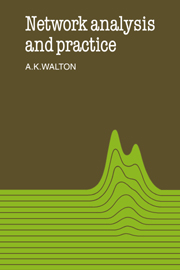Book contents
- Frontmatter
- Contents
- Preface
- 1 Electric charge, field and potential
- 2 Electric current, resistance and electromotive force
- 3 Direct-current networks
- 4 Capacitance, inductance and electrical transients
- 5 Introduction to the steady-state responses of networks to sinusoidal sources
- 6 Transformers in networks
- 7 Alternating-current instruments and bridges
- 8 Attenuators and single-section filters
- 9 Multiple-section filters and transmission lines
- 10 Signal analysis of nonlinear and active networks
- 11 Fourier and Laplace transform techniques
- 12 Filter synthesis
- Mathematical background appendices
- Problems
- Answers
- Solutions
- Index
10 - Signal analysis of nonlinear and active networks
Published online by Cambridge University Press: 05 June 2012
- Frontmatter
- Contents
- Preface
- 1 Electric charge, field and potential
- 2 Electric current, resistance and electromotive force
- 3 Direct-current networks
- 4 Capacitance, inductance and electrical transients
- 5 Introduction to the steady-state responses of networks to sinusoidal sources
- 6 Transformers in networks
- 7 Alternating-current instruments and bridges
- 8 Attenuators and single-section filters
- 9 Multiple-section filters and transmission lines
- 10 Signal analysis of nonlinear and active networks
- 11 Fourier and Laplace transform techniques
- 12 Filter synthesis
- Mathematical background appendices
- Problems
- Answers
- Solutions
- Index
Summary
Two-terminal nonlinear networks
The signal responses of two and four-terminal passive linear networks have been considered extensively in the previous six chapters. Attention is now turned to deducing the signal responses of both active and passive nonlinear networks, a topic of great importance in view of the key roles that nonlinear devices play in electronics. The topic has already been briefly broached, of course, in section 5.9, where certain consequences of nonlinearity were established by examining a few illustrative passive circuits. At this juncture the objective is to treat the analysis of nonlinear circuits in a much wider context and in a much more general manner.
Graphical analysis of the response of any nonlinear network can be achieved through its terminal static characteristic or characteristics irrespective of the magnitudes of the signals involved. This approach is, however, clearly most appropriate under large-signal conditions. At the opposite extreme, whenever the signals in a nonlinear network are small enough, the network is effectively linear with respect to the signals so that the methods developed for linear network analysis may be applied with advantage. Although maintenance of such small-signal conditions may appear somewhat restrictive, their occurrence is quite widespread. Electronic systems are very often concerned with processing weak signals and sometimes the nonlinearity involved is sufficiently slight for quite large signals to qualify as small enough for the purpose of linear analysis.
Explanation of the methods of large and small-signal analysis of nonlinear networks is best undertaken initially in terms of two-terminal networks.
- Type
- Chapter
- Information
- Network Analysis and Practice , pp. 220 - 251Publisher: Cambridge University PressPrint publication year: 1987



